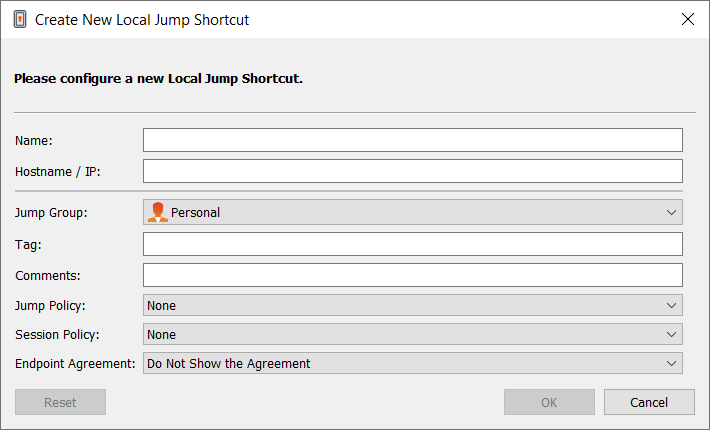Use Local Jump for Unattended Access to Computers on Your Local Network
Local Jump enables a privileged user to connect to an unattended remote computer on their local network. Within the local area network, the BeyondTrust user's computer can initiate a session to a Windows system directly without using a Jumpoint, if appropriate user permissions are enabled. A Jumpoint is needed only when the BeyondTrust user's computer cannot access the target computer directly.
Local Jump is only available for Windows systems. Jump Clients are needed for remote access to Mac computers. To Jump to a Windows computer without a Jump Client, that computer must have Remote Registry Service enabled (disabled by default in Vista) and must be on a domain.
Create a Local Jump Shortcut
To create a Local Jump shortcut, click the Create button in the Jump interface. From the dropdown, select Local Jump. Local Jump shortcuts appear in the Jump interface along with Jump Clients and other types of Jump Item shortcuts.
Enter a Name for the Jump Item. This name identifies the item in the session tabs. This string has a maximum of 128 characters.
Enter the Hostname / IP of the system you wish to access.
Move Jump Items from one Jump Group to another using the Jump Group dropdown. The ability to move Jump Items to or from different Jump Groups depends upon your account permissions.
Further organize Jump Items by entering the name of a new or existing Tag. Even though the selected Jump Items are grouped together under the tag, they are still listed under the Jump Group in which each Jump Item is pinned. To move a Jump Item back into its top-level Jump Group, leave this field blank.
Jump Items include a Comments field for a name or description, which makes sorting, searching, and identifying Jump Items faster and easier.
To set when users are allowed to access this Jump Item, if a notification of access should be sent, or if permission or a ticket ID from your external ticketing system is required to use this Jump Item, choose a Jump Policy. These policies are configured by your administrator in the /login interface.
Choose a Session Policy to assign to this Jump Item. The session policy assigned to this Jump Item has the highest priority when setting session permissions. The ability to set a session policy depends on your account permissions.
Choose an Endpoint Agreement to assign to this Jump Item. Depending on what is selected, an endpoint agreement is displayed. If there is no response, the agreement is automatically accepted or rejected.
Use a Local Jump Shortcut
To use a Jump shortcut to start a session, select the shortcut from the Jump interface and click the Jump button.
A dialog box opens for you to enter administrative credentials to the remote computer in order to complete the Jump. The administrative rights must be either a local administrator on the remote system or a domain administrator.
The client files are pushed to the remote system, and a session attempts to start.
Jump Items can be set to allow multiple users to simultaneously access the same Jump Item. If set to Join Existing Session, other users are able to join a session already underway. The original owner of the session receives a note indicating another user has joined the session, but is not allowed to deny them access. For more information on simultaneous Jumps, please see Jump Item Settings.


